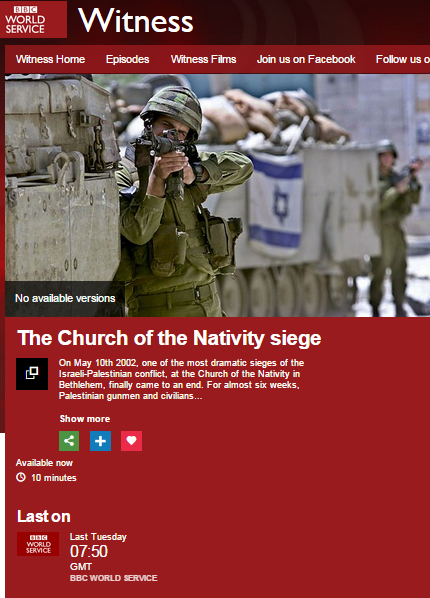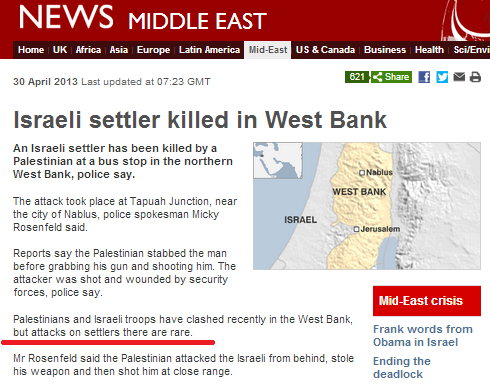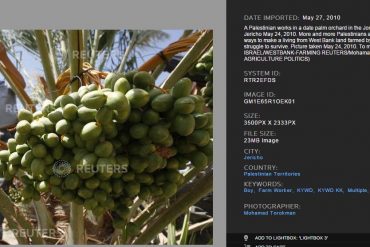As readers may be aware, a production by the ‘Freedom Theatre of Palestine’ is currently on tour in the UK.
“The theater company, based in the West Bank town of Jenin, structured the play around the April 2002 siege of the Church of the Nativity in Bethlehem. The company, whose mission is “generating cultural resistance,” is bringing the play to the United Kingdom in May and is set to perform in a number of locales with large Jewish communities. According to the theater’s website, “The Siege” is supported by the EU, the British Council and the Roddick Foundation.
It will open in Manchester at Salford’s Lowry Theatre on May 13 and 14, and will then tour Britain, with performances at London’s Battersea Arts Centre and major stages in Leeds, Birmingham, Nottingham and Glasgow, as well as some smaller venues.”
Not surprisingly, the play has received rave reviews from the ISM (International Solidarity Movement) which at the time had members acting as voluntary human shields for the wanted terrorists inside the church. The ISM also provides some insight into the aims behind both the production itself and its British tour.
“At the Freedom Theatre, Cultural Resistance is their way of defying the occupation. Ahmed Jamil Tobassi, one of the actors from the show, explained that among many other things, theatre creates a context that can support other forms of resistance. It revives stories, gives people a way of expressing themselves and ultimately frees the mind. The idea of cultural resistance is to work alongside other forms of resistance, not against. Yet “if you cannot start by deconstructing the occupation within yourself, how are you going to be able to free the country from the bigger, external occupation?” argues Jonatan Stanczak, managing director of the Theatre.
During the months of May and June, this play will be touring the United Kingdom, a country the theatre group has not yet been too. It is also as a message for the British to take responsibility for their prominent role in the ethnic cleansing of Palestinians and the ongoing occupation.”
Coincidentally, or not, the BBC World Service chose to revisit the story of the 2002 events at the Church of the Nativity in two recent radio programmes.
The May 12th edition of ‘Witness‘, presented by Louise Hidalgo, was devoted to accounts from a Franciscan priest and an American photographer who were both present at the time. Among the many notable features of the programme (not least the chosen illustrative image) is the lack of essential context in Hidalgo’s inserts of ‘background’.
“Today we go back to May 2002 and one of the most dramatic sieges of the Israeli-Palestinian conflict. For 38 days a group of Palestinian gunmen and civilians and nuns and monks have been holed up inside one of Christianity’s most holy sites – the Church of the Nativity in Bethlehem – surrounded by the Israeli army.” […]
“The stand-off had begun in early April when Israeli tanks had entered Bethlehem as part of a series of raids across the West Bank. As the Israeli army moved into the town, local civilians and Palestinian militants fled into Manger Square. When troops opened fire there, many of them ran into the church to seek sanctuary.”
What Hidalgo describes as “a series of raids” was in fact Operation Defensive Shield. She makes no mention of the fact that by the time that operation began, the second Intifada had been underway for a year and a half and around 300 Israelis had already been murdered in terror attacks. Neither does Hidalgo clarify that the catalyst for the operation was the terror attack on the Park Hotel in Netanya on Pesach Eve, in which thirty civilians were murdered and 140 injured. As far as BBC audiences are concerned, the Israeli army simply woke up one morning and decided to carry out “raids”.
Contrary to the impression given by Hidalgo’s account, the Israeli army was not the only side to open fire before the wanted terrorists broke into the Church of the Nativity by shooting off the door lock. As the Guardian reported at the time:
“Witnesses described desperate close quarter fighting in the old part of Bethlehem, a warren of narrow alleys and stone streets behind Manger Square, as Israeli forces went from house to house and entered religious buildings searching for Palestinian fighters.
Outgunned, the Palestinians fought desperately to keep Israeli troops out of Manger Square itself. Palestinian gunmen have frequently used the area around the Church of the Nativity as a refuge, with the expectation that Israel would try to avoid fighting near it.”
Neither does Hidalgo inform listeners of the existence of accounts which suggest that the terrorists’ use of the holy site was pre-planned and tactically motivated.
“As confirmed by a senior Tanzim commander, Abdullah Abu-Hadid, “The idea was to enter the church in order to create international pressure on Israel….We knew beforehand that there was two years’ worth of food for 50 monks. Oil, beans, rice, olives. Good bathrooms and the largest wells in old Bethlehem. You didn’t need electricity because there were candles. In the yard they planted vegetables. Everything was there.””
And:
“The conspiracy was to make a siege and put all the fighters inside the church so Israel would make the siege. People from the Palestinian Authority collaborated with this conspiracy,” said Eiman Abu Eita, Fatah’s representative in the Bethlehem satellite town of Beit Sahour who at the time of the siege was Beit Sahour’s al-Aqsa Brigades chief.”
Remarkably, at no point throughout this whole programme are listeners told that the people described variously as “gunmen”, “militants” or merely “men” were in fact wanted terrorists. That coy approach to an essential part of the story is reinforced in the account given by photographer Carolyn Cole.
“I do remember when the men were saying goodbye to the leaders of the Al Aqsa Martyr Brigade who was going into exile in Cyprus – Ibrahim Abayat – and I had taken a portrait of him earlier in the week. I didn’t really know his background. I had no idea why he was the most wanted man in the church but there was a group of them who left the church first and so all the other men were gathering around them. They made a line and everyone was hugging as those men left.”
Despite having had thirteen years to find out about Abayat’s “background”, Cole and her host Hidalgo refrain from telling BBC audiences the facts.
“Abayat was born in 1973, and is a resident of the city of Bethlehem. He is head of the Fatah Tanzim terrorist organization in the city.
After the death of Atef Abayat, Ibrahim took over as the Bethlehem commander of the Tanzim. In this capacity, he was involved in dispatching and executing dozens of shooting and bombing attacks, which resulted in the death and injury of scores of Israelis. Abayat also orchestrated and participated in the shooting and mortar attacks on the Jerusalem neighborhood of Gilo and on the Bethlehem bypass roads.
Aside from the shooting and mortar attacks, Ibrahim Abayat was also involved in the following murderous terrorist attacks:
20 September 2001 – A shooting attack on an Israeli vehicle near the community of Tekoa, in which Sarit Amrani was killed.
16 July 2001 – The detonation of an explosive charge on the Beit Safafa -Talpiot bridge, Jerusalem.
15 January 2002 – The abduction and murder of Avi Boaz, a US citizen residing in Israel. Boaz was stopped at a Palestinian roadblock near Beit Sahour. There he was abducted by Abayat’s operatives, who took him to Bethlehem, and upon Abayat’s instructions, shot him to death.
18 February 2002 – The detonation of a car bomb at the Zaim checkpoint, resulting in the death of an Israeli policeman.
25 February 2002 – A shooting attack at an Israeli vehicle close to the Tekoa junction. Avraham Fisch and Aharon Gorov of Nokdim were killed in the attack, and Tamar Lipschitz, in an advanced stage of pregnancy, was wounded in the attack.
2 March 2002 – A shooting attack at a vehicle on the ‘Tunnel Route’ south of Jerusalem. Devorah Friedman was killed in the attack.
June 14, 2002 – Involvement in the planning and execution of the terrorist murder of Israeli intelligence officer, Yehuda Edri.
In addition, incriminating evidence has been found linking him to an attempt to detonate an explosive charge, in the Jerusalem suburb of Tzur Haddassah, on 31 January 2002. The explosive charge was discovered and neutralized by Israeli police sappers.”
According to some accounts from the time, Abayat also murdered Palestinians.
“Residents also said that Mr. Ja’ara and another top leader, Ibrahim Abayat, took nine Muslims whom they suspected of collaborating with Israel into an apartment near Manger Square and fatally shot them.
The executions took place shortly before the April 2 gunbattle between Israeli troops and Palestinian fighters that sent more than 200 Palestinians fleeing into the church, where they remained for 39 days.
Abayat, in a phone interview from inside the church while the siege was under way, said he was personally responsible for the killings.
He said there was no need for a trial because “it was a well-known fact that these people were linked to Israel.””
No less euphemistic is the programme’s presentation of the terrorist supporting ISM with which Cole entered the church and which she was apparently covering at the time.
Hidalgo: “Then one day, photographer Carolyn Cole had the kind of break that journalists can only dream of. It was late afternoon, she was standing at the barricade when she spotted a group of foreign protesters sneaking around the side of the church.” […]
“The protesters had coordinated by mobile phone with some of the Palestinians inside.”
Interestingly, Hidalgo makes no attempt to clarify what those so-called “foreign protesters” were actually doing in a war zone but the ISM’s press release from the time does supply some of the missing background.
“BETHLEHEM (May 2, 2002) – Ten members of the International Solidarity Movement (ISM) entered the besieged Church of Nativity at about 5:45 pm, walking past Israeli occupation soldiers. A further thirteen persons, working as decoys were arrested by the Israeli soldiers. All those inside are determined to remain until the Israelis lift their siege on the city of Bethlehem.
The ISM conceived of an intricate plan to move past Israeli soldiers outside the Church in several separate but coordinated groups carrying placards denouncing the ongoing Israeli occupation. In a move orchestrated with contacts within, two ISM teams were able to reach the Church and enter its main door before Israeli soldiers could respond. Every member carried with them food and other critical supplies badly needed by the Palestinians holed up inside. The Israeli army has denied the Palestinians, besieged since April 1, 2002, sufficient amounts of food.
This constitutes the latest in a series of success by the ISM to defy the Israeli occupation and to demonstrate to the world that the international community takes a firm stance against the illegal Israeli occupation of Palestinian territory. In light of the failure for the international community, namely the United States and the United Nations to act to help protect the Palestinian people and secure their universal rights, the ISM has had to operate on its own. Prior to this, the ISM has twice circumvented Israeli occupation forces to place activists inside of President Arafat’s compound in Ramallah.”
Hidalgo’s context-free, romanticized presentation of events was broadcast yet again to BBC World Service listeners in the May 16th edition of ‘The History Hour’ and also promoted as a podcast. There it was introduced by presenter Max Pearson as follows:
“But we begin in that hotbed of historical drama; the Middle East. Ever since the creation of Israel after the Second World War – carved out of land previously inhabited by the Palestinians – there’s been tension between Jews and Arabs. This tension is frequently expressed in violence; sometimes in war. And the holy shrines of three great religions – Judaism, Islam and Christianity – have not escaped unscathed. So it was in May 2002 when one of the most dramatic sieges of the Israeli-Palestinian conflict unfolded in Bethlehem.” [emphasis added]
Pearson makes no attempt to explain to listeners what “have not escaped unscathed” meant in this particular case.
“The 39 day standoff in Bethlehem ended yesterday when 13 of the militiamen camped in the church were flown to Cyprus on their way to exile in Europe. Another 26 militiamen were released into the Gaza Strip, where they fired assault rifles in the air to acknowledge cheers from crowds lining the streets. Seventy-three Palestinian policemen and civilians were set free.
Israeli bomb experts swept the church at the request of the priests and found 40 explosive devices, several booby-trapped and hidden in corners and behind cupboards, the army said. The sappers neutralised 25 devices and an American bomb squad with sniffer dogs disarmed the rest, according to a military source.
In their joy over having control over the shrine again, Greek and Franciscan priests conducted a service, and bells rang for several minutes.
When Israeli troops later withdrew from Bethlehem, hundreds of residents who had been trapped in their houses by curfew during much of the standoff entered the church. Many lit candles near the birth grotto.
”This is the place where Jesus was born. I can’t believe this is the house of God, just look at it,” 18-year-old Sandy Shaheen, a Bethlehem Christian, said crying.
The shrine reeked of urine and dirty dishes, blankets, cigarette butts and a mass of other garbage lay about. But the building was largely unscathed by the standoff.”
Despite the lack of important background information and context and regardless of the absence of any input on this story from the Israeli side, the BBC chose to present this clearly partisan anecdotal version of events as ‘history’. That would be bad enough at any time, but in a month in which BBC audiences in the UK will likely be hearing a lot about the Jenin Freedom Theatre’s agitprop, it is all the more striking that the organisation tasked with building “a global understanding of international issues” has elected to put politics before the provision of accurate and impartial information.
Related Articles:
BBC WS ‘Witness’ erases Arafat’s terrorism




